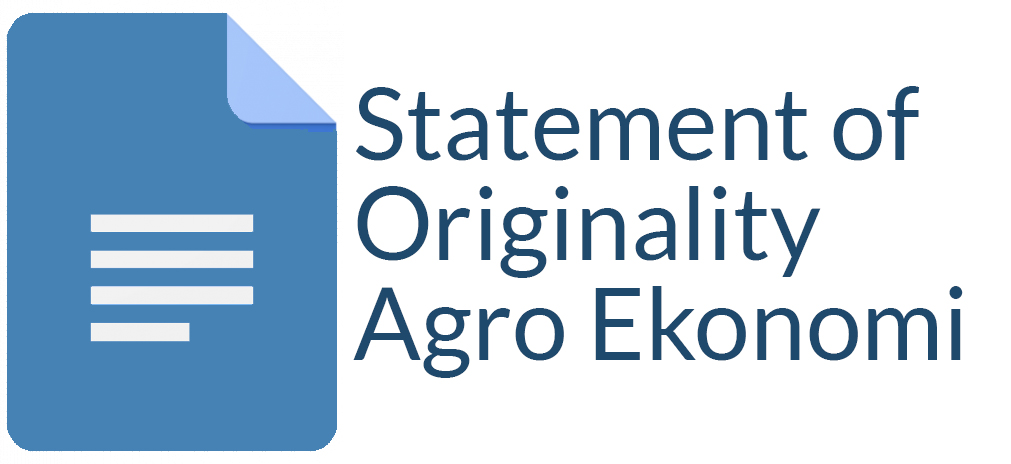Green Marketing Attributes of Coffee Shops, Purchasing Interests, Lifestyles: What Really Affects Consumer Satisfaction?
M. Zul Mazwan(1*), Livia Windiana(2), Gigin Mahdalena(3), Dyah Erni Widyastuti(4)
(1) Agribusiness Department, Faculty of Agriculture and Animal Science, University of Muhammadiyah Malang
(2) Agribusiness Department, Faculty of Agriculture and Animal Science, University of Muhammadiyah Malang
(3) Agribusiness Department, Faculty of Agriculture and Animal Science, University of Muhammadiyah Malang
(4) Agribusiness Department, Faculty of Agriculture and Animal Science, University of Muhammadiyah Malang
(*) Corresponding Author
Abstract
Green marketing strategies continue to grow as public awareness of environmental issues increases. Green marketing is applied to the marketing of environmentally friendly products including packaging and labeling with environmentally friendly standards. This study aims to learn the impact of green marketing strategies on purchasing interests and consumer satisfaction with coffee drinks in Malang, Indonesia. This study also explores the role of lifestyle in mediating the effect of green marketing on purchasing interest and consumer satisfaction. The sample is determined using the accidental sampling method with a sample size of 100 customers of Starbucks in Malang, Indonesia. The analytical method used is PLS (Partial Least Square). The findings show that green marketing strategies positively and significantly influence lifestyle, purchasing interest, and consumer satisfaction. The mediation variable (lifestyle) also positively and significantly influences purchasing interest and consumer satisfaction. Better green marketing strategy used will impact on how the community behaving in a healthy lifestyle, undoubtedly affecting the increase in buying interest and consumer satisfaction.
Keywords
Full Text:
PDFReferences
Aagerup, U., & Nilsson, J. (2016). Green consumer behavior: being good or seeming good? Journal of Product and Brand Management, 25(3), 274–284. https://doi.org/10.1108/JPBM-06-2015-0903
Agrawal, A.D. and Das, M. (2013) ‘Green Marketing: Sustainable Marketing Strategy’, VII(1), pp. 17–31. https://www.indiraedu.com/assets/doc/publications/IMR/IMRJan2013.pdf#page=19
Bailey, A. A., Mishra, A., & Tiamiyu, M. F. (2016). Green consumption values and Indian consumers’ response to marketing communications. Journal of Consumer Marketing, 33(7), 562–573. https://doi.org/10.1108/JCM-12-2015-1632
Barbulescu, A. (2017). Modeling the impact of the human activity, behavior and decisions on the environment. Marketing and green consumer (Special Issue). Journal of Environmental Management, 204, 813. https://doi.org/10.1016/j.jenvman.2017.10.028
Chen, M. F., & Lee, C. L. (2015). The impacts of green claims on coffee consumers’ purchase intention. British Food Journal, 117(1), 195–209. https://doi.org/10.1108/BFJ-07-2013-0196
Confente, I., Scarpi, D., & Russo, I. (2020). Marketing a new generation of bio-plastics products for a circular economy: The role of green self-identity, self-congruity, and perceived value. Journal of Business Research, 112(June 2019), 431–439. https://doi.org/10.1016/j.jbusres.2019.10.030
Dangelico, R. M., & Vocalelli, D. (2017). “Green Marketing”: An analysis of definitions, strategy steps, and tools through a systematic review of the literature. Journal of Cleaner Production, 165, 1263–1279. https://doi.org/10.1016/j.jclepro.2017.07.184
Domegan, C. (2021). Social marketing and behavioural change in a systems setting. Current Opinion in Environmental Science and Health, 23, 100275. https://doi.org/10.1016/j.coesh.2021.100275
Gordon-Wilson, S., & Modi, P. (2015). Personality and older consumers’ green behaviour in the UK. Futures, 71, 1–10. https://doi.org/10.1016/j.futures.2015.05.002
Groening, C., Sarkis, J., & Zhu, Q. (2018). Green marketing consumer-level theory review: A compendium of applied theories and further research directions. Journal of Cleaner Production, 172, 1848–1866. https://doi.org/10.1016/j.jclepro.2017.12.002
Hasan, Z., & Ali, N. A. (2015). The Impact of Green Marketing Strategy on the Firm’s Performance in Malaysia. Procedia - Social and Behavioral Sciences, 172, 463–470. https://doi.org/10.1016/j.sbspro.2015.01.382
Jang, Y.J., Kim, W.G. and Lee, H.Y. (2015) ‘Coffee shop consumers’ emotional attachment and loyalty to green stores: The moderating role of green consciousness’, International Journal of Hospitality Management, 44, 146–156. https://doi.org/10.1016/j.ijhm.2014.10.001.
Jeong, E.H. et al. (2014) ‘The impact of eco-friendly practices on green image and customer attitudes: An investigation in a café setting’, International Journal of Hospitality Management, 41, 10–20. https://doi.org/10.1016/j.ijhm.2014.03.002.
Kao, T. F., & Du, Y. Z. (2020). A study on the influence of green advertising design and environmental emotion on advertising effect. Journal of Cleaner Production, 242, 118294. https://doi.org/10.1016/j.jclepro.2019.118294
Kumar, P. (2015). Green marketing innovations in small Indian firms. World Journal of Entrepreneurship, Management and Sustainable Development, 11(3), 176–190. https://doi.org/10.1108/wjemsd-01-2015-0003
Kumar, P., & Polonsky, M. J. (2017). An analysis of the green consumer domain within sustainability research: 1975 to 2014. Australasian Marketing Journal, 25(2), 85–96. https://doi.org/10.1016/j.ausmj.2017.04.009
Kwok, L., Huang, Y. K., & Hu, L. (2016). Green attributes of restaurants: What really matters to consumers? International Journal of Hospitality Management, 55, 107–117. https://doi.org/10.1016/j.ijhm.2016.03.002
Ling, R., Sit, H. F., Balaji, S., Lam, A. I. F., Latkin, C. A., Tucker, J. D., & Hall, B. J. (2021). Crowdsourcing to design a marketing package to promote a WHO digital mental health intervention among Chinese young adults. Internet Interventions, 25, 100397. https://doi.org/10.1016/j.invent.2021.100397
Lunde, M. B. (2018). Sustainability in marketing: a systematic review unifying 20 years of theoretical and substantive contributions (1997–2016). AMS Review, 8(3–4), 85–110. https://doi.org/10.1007/s13162-018-0124-0
Majerova, J. (2015). Analysis of Slovak Consumer’s Perception of the Green Marketing Activities. Procedia Economics and Finance, 26(15), 553–560. https://doi.org/10.1016/s2212-5671(15)00954-5
Mufarida, B. (2019, July). KLHK Sebut Indonesia Darurat Sampah Plastik. SINDONews, 1. https://nasional.sindonews.com/berita/1424598/15/klhk-sebut-indonesia-darurat-sampah-plastik
Murin, I., Marková, I., Zelený, J., & Jaďuďová, J. (2015). Green Marketing as a Tool Influencing Consumerś Behavior: Slovak Case Study of Regional Mark Preference. Procedia Economics and Finance, 34(15), 260–267. https://doi.org/10.1016/s2212-5671(15)01628-7
Nadanyiova, M., Kicova, E., & Rypakova, M. (2015). Green Marketing and its Exploitation in Slovak Companies. Procedia Economics and Finance, 26(15), 219–226. https://doi.org/10.1016/s2212-5671(15)00820-5
Narula, S. A., & Desore, A. (2016). Framing green consumer behaviour research: Opportunities and challenges. Social Responsibility Journal, 12(1), 1–22. https://doi.org/10.1108/SRJ-08-2014-0112
Osman, A., Othman, Y. H., Salahudin, S. N., & Abdullah, M. S. (2016). The Awareness and Implementation of Green Concepts in Marketing Mix: A Case of Malaysia. Procedia Economics and Finance, 35, 428–433. https://doi.org/10.1016/s2212-5671(16)00053-8
Rana, J., & Paul, J. (2017). Consumer behavior and purchase intention for organic food: A review and research agenda. Journal of Retailing and Consumer Services, 38(February), 157–165. https://doi.org/10.1016/j.jretconser.2017.06.004
Royne, M. B., Thieme, J., Levy, M., Oakley, J., & Alderson, L. (2016). From thinking green to buying green: consumer motivation makes the difference. Journal of Business Strategy, 37(3), 37–43. https://doi.org/10.1108/JBS-12-2014-0151
Sarkar, A.N. (2012) ‘Green Branding and Eco-innovations for Evolving a Sustainable Green Marketing Strategy’, Asia-Pacific Journal of Management Research and Innovation, 8(1), 39–58. https://doi.org/10.1177/2319510x1200800106.
Setiawan, S. R. D. (2019, January). Perilaku Masyarakat Gunakan Kantong Plastik Dipandang Harus Berubah. Kompas.Com, 1. https://ekonomi.kompas.com/read/2019/01/03/225005826/perilaku-masyarakat-gunakan-kantong-plastik-dipandang-harus-berubah
Simão, L., & Lisboa, A. (2017). Green Marketing and Green Brand – The Toyota Case. Procedia Manufacturing, 12(December 2016), 183–194. https://doi.org/10.1016/j.promfg.2017.08.023
Suki, N. M., Suki, N. M., & Azman, N. S. (2016). Impacts of Corporate Social Responsibility on the Links Between Green Marketing Awareness and Consumer Purchase Intentions. Procedia Economics and Finance, 37(16), 262–268. https://doi.org/10.1016/s2212-5671(16)30123-x
Tan, L. P., Johnstone, M. L., & Yang, L. (2016). Barriers to green consumption behaviours: The roles of consumers’ green perceptions. Australasian Marketing Journal, 24(4), 288–299. https://doi.org/10.1016/j.ausmj.2016.08.001
Tong, Q., Anders, S., Zhang, J., & Zhang, L. (2020). The roles of pollution concerns and environmental Thknowledge in making green food choices: Evidence from Chinese consumers. Food Research International, 130, 108881. https://doi.org/10.1016/j.foodres.2019.108881
Windiana, L. et al. (2020) ‘The Effect of Green Marketing toward the Consumers Buying Interest of Starbucks Coffee Mediated By Brand Image’, Habitat, 31(1), 36–41. https://doi.org/10.21776/ub.habitat.2020.031.1.4.
Windiana, L., Mazwan, M. Z., & Mahdalena, G. (2021). Consumer Attitudes and Purchasing Interests of Coffee Shop which Implement Green Marketing and Non-Green Marketing in Malang, Indonesia. E3S Web of Conferences, 232, 02010. https://doi.org/10.1051/e3sconf/202123202010
Yuswantoro. (2019, April). KLHK Ajak Kota Malang, Kelola Sampah di Pusat Daur Ulang. SINDONews. https://daerah.sindonews.com/artikel/jatim/9255/klhk-ajak-kota-malang-kelola-sampah-di-pusat-daur-ulang
Zhao, H. H., Gao, Q., Wu, Y. P., Wang, Y., & Zhu, X. D. (2014). What affects green consumer behavior in China? A case study from Qingdao. Journal of Cleaner Production, 63, 143–151. https://doi.org/10.1016/j.jclepro.2013.05.021
Zhu, Q., & Sarkis, J. (2016). Green marketing and consumerism as social change in China: Analyzing the literature. International Journal of Production Economics, 181, 289–302. https://doi.org/10.1016/j.ijpe.2016.06.006
Zubair, M., Wang, X., Iqbal, S., Awais, M., & Wang, R. (2020). Attentional and emotional brain response to message framing in context of green marketing. Heliyon, 6(9), e04912. https://doi.org/10.1016/j.heliyon.2020.e04912
Article Metrics
Refbacks
- There are currently no refbacks.
Copyright (c) 2023 Agro Ekonomi

This work is licensed under a Creative Commons Attribution-ShareAlike 4.0 International License.
View My Stats











